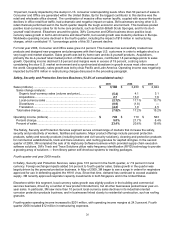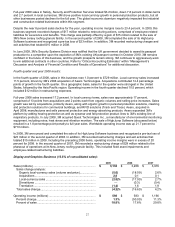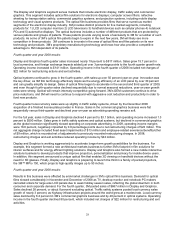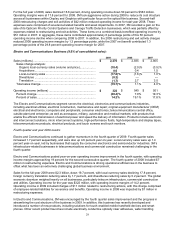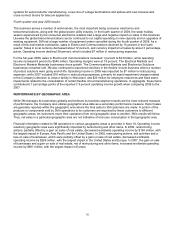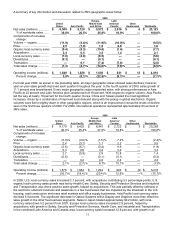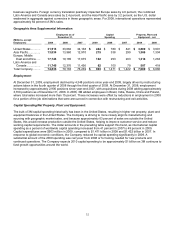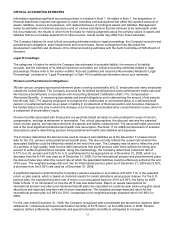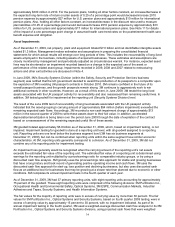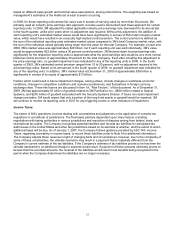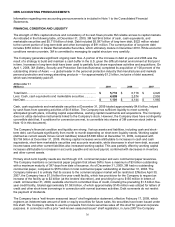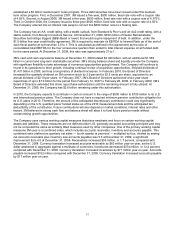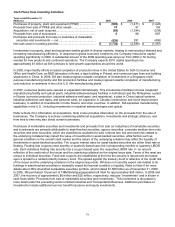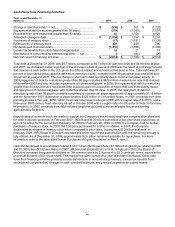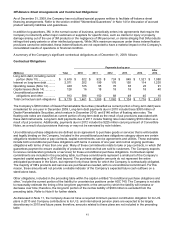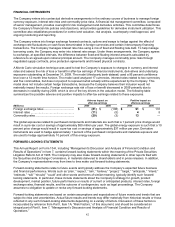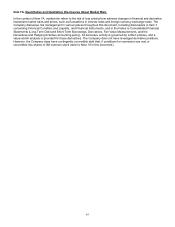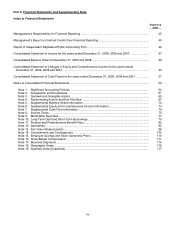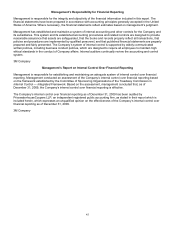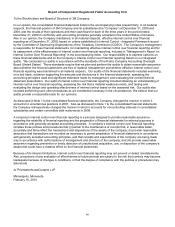3M 2009 Annual Report Download - page 42
Download and view the complete annual report
Please find page 42 of the 2009 3M annual report below. You can navigate through the pages in the report by either clicking on the pages listed below, or by using the keyword search tool below to find specific information within the annual report.
36
NEW ACCOUNTING PRONOUNCEMENTS
Information regarding new accounting pronouncements is included in Note 1 to the Consolidated Financial
Statements.
FINANCIAL CONDITION AND LIQUIDITY
The strength of 3M’s capital structure and consistency of its cash flows provide 3M reliable access to capital markets.
As indicated in the following table, at December 31, 2009, 3M had $4.6 billion of cash, cash equivalents, and
marketable securities and $5.710 billion of debt. Debt included $5.097 billion of long-term debt, $522 million related
to the current portion of long-term debt and other borrowings of $91 million. The current portion of long-term debt
includes $350 million in Dealer Remarketable Securities, which ultimately mature in December 2010. While economic
conditions remain uncertain, 3M is committed to managing its capital structure very carefully.
The Company generates significant ongoing cash flow. A portion of the increase in debt at year-end 2008 was the
result of a strategy to build and maintain a cash buffer in the U.S. given the difficult market environment at that point
in time. Increases in long-term debt have been used to partially fund share repurchase activities and acquisitions. On
April 1, 2008, 3M (Safety, Security and Protection Services Business) completed its acquisition of 100 percent of the
outstanding shares of Aearo — a global leader in the personal protection industry that manufactures and markets
personal protection and energy absorbing products — for approximately $1.2 billion, inclusive of debt assumed,
which was immediately paid off.
At December 31
(Millions) 2009 2008 2007
Total Debt....................................................................................... $ 5,710 $ 6,718 $ 4,920
Less: Cash, cash equivalents and marketable securities .............. 4,609 2,574 2,955
Net Debt ......................................................................................... $ 1,101 $ 4,144 $ 1,965
Cash, cash equivalents and marketable securities at December 31, 2009 totaled approximately $4.6 billion, helped
by cash flows from operating activities of $4.9 billion. The Company has sufficient liquidity to meet currently
anticipated growth plans, including capital expenditures, working capital investments and acquisitions. The Company
does not utilize derivative instruments linked to the Company’s stock. However, the Company does have contingently
convertible debt that, if conditions for conversion are met, is convertible into shares of 3M common stock (refer to
Note 10 in this document).
The Company’s financial condition and liquidity are strong. Various assets and liabilities, including cash and short-
term debt, can fluctuate significantly from month to month depending on short-term liquidity needs. Working capital
(defined as current assets minus current liabilities) totaled $5.898 billion at December 31, 2009, compared with
$3.759 billion at December 31, 2008. Working capital increases were attributable to increases in cash and cash
equivalents, short-term marketable securities and accounts receivable, while decreases in short-term debt, accrued
income taxes and other current liabilities also increased working capital. This was partially offset by working capital
increases attributable to increases in accounts payable and accrued payroll, combined with decreases in inventory
and other current assets.
Primary short-term liquidity needs are met through U.S. commercial paper and euro commercial paper issuances.
The Company maintains a commercial paper program that allows 3M to have a maximum of $3 billion outstanding
with a maximum maturity of 397 days from date of issuance. As of December 31, 2009, 3M had no outstanding
commercial paper, compared to $575 million in total commercial paper outstanding at December 31, 2008. The
Company believes it is unlikely that its access to the commercial paper market will be restricted. Effective April 30,
2007, the Company has a $1.5-billion five-year credit facility, which has provisions for the Company to request an
increase of the facility up to $2 billion (at the lenders’ discretion), and providing for up to $150 million in letters of
credit. At December 31, 2009, available short-term committed lines of credit, including the preceding $1.5 billion five-
year credit facility, totaled approximately $1.593 billion, of which approximately $145 million was utilized for letters of
credit and other short-term borrowings in connection with normal business activities. Debt covenants do not restrict
the payment of dividends.
The Company has a “well-known seasoned issuer” shelf registration statement, effective February 17, 2009, which
registers an indeterminate amount of debt or equity securities for future sales. No securities have been issued under
this shelf. The Company intends to use the proceeds from future securities sales off this shelf for general corporate
purposes. In connection with a prior “well-known seasoned issuer” shelf registration, in June 2007 the Company


